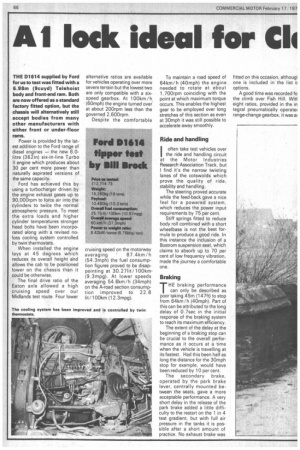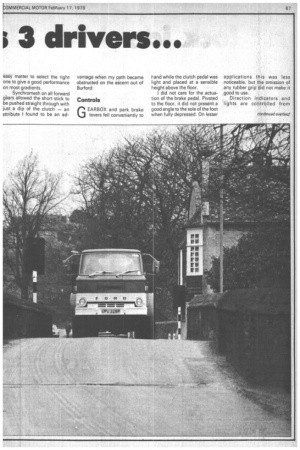Al lock ideal for CI4
Page 68

Page 69

Page 71

If you've noticed an error in this article please click here to report it so we can fix it.
; 3 drivers...
THE 01614 supplied by Ford for us to test was fitted with a 6.98m (9cuyd) Teiehoist body and front-end ram. Both are now offered as a standard factory fitted option, but the chassis will alternatively still accept bodies from many other manufacturers with either front or under-floor rams.
Power is provided by the latest addition to the Ford range of diesel engines — the new 6.0litre (362in) six-in-line Turbo II engine which produces about 30 per cent more power than naturally aspirated versions of the same capacity.
Ford has achieved this by using a turbocharger driven by the engine exhaust gases up to 90,000rpm to force air into the cylinders to twice the normal atmospheric pressure. To meet the extra loads and higher cylinder temperatures stronger head bolts have been incorporated along with a revised noloss cooling system controlled by twin'thermostats.
When installed the engine lays at 45 degrees which reduces its overall height and allows the cab to be positioned lower on the chassis than it could be otherwise.
The final drive ratio of the Eaton axle allowed a high cruising speed over our Midlands test route. Four lower alternative ratios are available for vehicles operating over more severe terrain but the lowest two are only compatible with a sixspeed gearbox. At 100km /h, (60mph) the engine turned over at about 200rpm less than the governed 2,600rpm. Despite the comfortable cruising speed on the motorway
averaging ' 87.4km/h (54.3mph) the fuel consumption figures proved to be disappointing at 30.271it/ 100km, (9.3Mpg). At lower speeds averaging 54.6km /h (34mph) on the A-road section consumption improved to 22.8 lit/100km (12.3mpg).
To maintain a road speed of 64km/ h (40mph) the engine needed to rotate at about 1,700rpm coinciding with the point at which maximum torque occurs. This enables the highest gear to be employed over long stretches of this section as even at 30mph it was still possible to accelerate away smoothly.
Ride and handling
I often take test vehicles over I the ride and handling circuit at the Motor Industries Research Association Track, but I find it's the narrow twisting lanes of the cotswolds which prove the quality of ride, stability and handling.
The steering proved accurate while the feed-back gave a nice feel for a powered system, which reduces the power input requirements by 75 per cent.
Stiff springs fitted to reduce body roll combined with a short wheelbase is not the best formula to produce a good ride. In this instance the inclusion of a Bostrorn suspension seat, which claims to absorb up to 70 per cent of low frequency vibration, made the journey a comfortable one.
Braking THE braking performance can only be described as poor taking 45m (147ft) to stop from 64km /h (40mph). Part of this can be attributed to the long delay of 0.7sec in the initial response of the braking system to reach its maximum efficiency.
The extent of the delay at the beginning of a braking stop can be crucial to the overall performance as it occurs at a time when the vehicle is travelling at its fastest. Had this been half as long the distance for the 30rnph stop for example, would have been reduced by 10 per cent.
The secondary brake, operated by the park brake lever, centrally mounted between the seats, gave a more acceptable performance. A very short delay in the release of the park brake added a little difficulty to the restart on the 1 in 4 test gradient, but with full air pressure in the tanks it is possible after a short amount of practice. No exhaust brake was fitted on this occasion, althougl one is included in the list c options. A good time was recorded fo the climb over Fish Hill. Witl eight ratios, provided in the in tegral pneumatically operate( range-change gearbox, it was al
easji. matter to select the right one to give a good performance on most gradients.
Synchromesh on all forward gears allowed the short stick to be pushed straight through with just a dip of the clutch — an attribute I found to be an ad
vantage when my path became obstructed on the ascent out of Burford
Controls GEARBOX and park brake levers fell conveniently to 'and while the clutch pedal was light and placed at a sensible height above the floor.
I did not care for the actuation of the brake pedal. Pivoted tp the floor, it did not present a good angle to the sole of the foot when fully depressed. On lesser applications this was less noticeable, but the omission of any rubber grip did not make it good to use.
Direction indicators and lights are controlled from steering-column-mounted stalks while the engine stop lever is placed below the rev counter on the dashboard next to the speedo and gauge for oil pressure, air pressure and battery charge.
The screen washer employs a floor-mounted rubber bowl to propel the liquid onto the screen, but it is mounted well forward in a central position so that a long stretch of the leg is needed for its operation.
When the water does reach the screen it is quickly removed by the wiper blade before it reaches the area most needed to be cleared because the jets are placed below the blade. But in any case a vehicle that is likely to work in site conditions requires the volume of water provided by an electric washer.
Visibility Visibility THE mirrors were firmly attached to each door. The one mounted on the offside could be positioned to give a good view to the rear including the area of the rear wheels.
The one fitted to the nearside also gave a good rearward view, but was obscured in part by the strip containing the quarter light in the door frame.
They stayed clean and the only time they had to be wiped was to remove condensation after encountering fog on the tops of the hills.
Site conditions FOR site conditions we visited a Hall Aggregate pit at lver, where the scrapers were still stripping top soil. The vehicle coped with most of the conditions at our disposal in normal drive but when extra traction was needed a simple lift of the switch engaged the diff lock. As long as the tyres reached a firm base, before sinking down to the axles, forward motion was maintained.
The nine yard body accepts a full level payload of gravel below the side panels. The tipping ram takes about 90 seconds to extend to its full limit when loaded.
Access to the engine is made good by a cab which tilts forward 50 degrees, but this is not necessary for daily checks of oil and water which can be carried out through a small hatch positioned behind the driver's seat.
Summary THE cab, now 10 years old, remains basically the same shape but with the addition of
insulation materials noise inside the cab had been reduced to a lcw level. Vision, ride and handling both on and off the road is good and only the braking performance detracted from the good overall performance. A short wheelbase, a good lock and the fact that it only requires a Class 3 licence to drive it makes it an ideal vehicle for local authorities, small builders and the owner-driver.
The basic price at .£10,039.26 for the 147in wheelbase D164 chassis-cab is still good value at £12,714.73 after tipper body gear, eightspeed gearbox, auxiliary springs, diff lock, suspension seat, laminated windscreen, tachometer, no-loss cooling and stack pipe extension options have been added.
























































































































